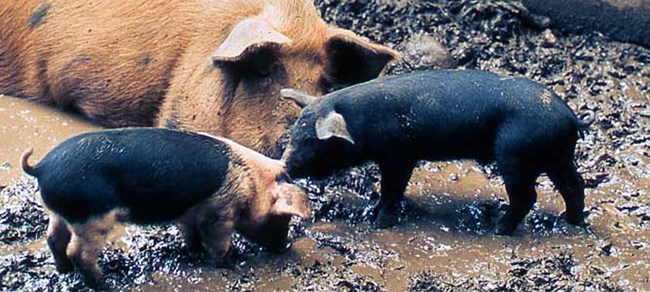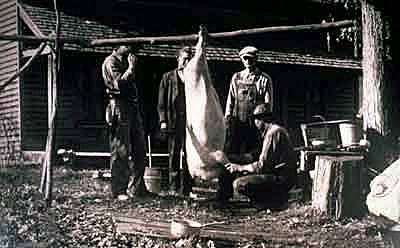
Historically, no farm animal better represents rural life in the mountains than the pig. It was by far the most numerous and prolific of farm livestock and was the most important source of meat. The Oconaluftee area in the North Carolina portion of what is now Great Smoky Mountains National Park is a good example. According to the 1880 Agricultural Census, 59 families in the Oconaluftee portion of the Smokies reported owning a total of more than 830 pigs in 1879. Individual ownership ranged from as few as two to more than 50. By comparison, the next most numerous livestock was sheep, with only about half as many. Hogs not only provided meat for the family, they were also often a source of additional income. As a cash crop, there was a big advantage to livestock—they could walk to market. Pigs were the primary source of meat for mountain families for several reasons. For one, almost every part of the animal could be used. Secondly, pigs were self sufficient and could be raised at little cost to the farmer. Pigs were especially good foragers and were allowed to roam the forest in search of food. They would eat many things that other livestock could not. Hogs used their tough snouts or “rooters” to dig up plant bulbs, roots, and insects, and would also eat frogs, snakes, and lizards. In the fall, they feasted on chestnuts, acorns, and other wild nuts. 
NPS Archives In an effort to avoid ownership disputes, hogs were “earmarked” with a variety of notches, slits, and holes that were cut or punched into their ears. Each farmer had his own earmark to distinguish his stock and the mark was often registered with the county court. To keep the animals from wandering too far afield or becoming wild, many farmers would periodically take salt and corn to a feeding spot in the forest. This also made it easier to catch the animals in the fall when it was time to select hogs to be fattened before butchering. Older hogs were usually chosen, while younger animals were left for next year. The pens used to house the hogs for fattening often resembled small log cabins, three to five logs high, and sometimes even included a split log floor to keep the animals from rooting their way out. The structure was usually topped with a roof of heavy planks or logs which in turn were weighted down with large rocks. These measures were needed not only to keep the hogs in, but also to keep bears out. Sometimes these pens were so small there was not even room for the animal to turn around, the idea being that the less they moved the faster they would gain weight. One farmer liked to say he fattened his hogs “till their eyes swole shut....” Even though hogs fattened on wild chestnuts produced tasty meat, many farmers preferred corn fattened hogs because they felt corn produced better lard. The animals were penned and fattened for anywhere from several weeks to more than a month. Butchering took place after the weather was cold enough to help preserve the meat until the curing process was complete. This activity often occurred around the end of November, although many farmers also waited until the moon and signs were right, preferring to kill the animals at full moon. Many felt that if the hog was killed during a shrinking or waning moon, the meat would also shrink a lot when cooked. 
NPS Archives On hog killing day, families usually started their preparations well before daylight. The number of hogs butchered depended on the needs of the family and might range from one to eight. The animals were usually killed by a sharp blow to the head or by shooting the animal in the head. The jugular vein was cut to drain the blood from the body, after which it was immersed in hot water or had hot water poured over it to loosen the hair so it could be scraped off. The carcass was then hung by its hind legs and the animal was gutted to remove the organs and intestines which were set aside for later use. It was moved to a table where it was butchered into various cuts such as tenderloin, shoulders, hams, and side meat. The fat trimmings were put into a large pot and heated to render the lard. Almost every part of the hog could be eaten, from the feet to the tail and right on out to the snout. The old saying was that you could use every part of the hog except the “squeal.” Some of it was eaten fresh while other parts were preserved for later use. Although smoke was sometimes part of the preservation process, salt was the primary ingredient for curing meat. Many families used salt mixed with other ingredients such as pepper, sugar, molasses, or saltpeter. Whatever the mixture, it was spread over the large pieces of meat. These were then placed on shelves or in boxes in the meathouse where they were stored during cold weather while the curing process took place. A meathouse of this type is preserved at the Mountain Farm Museum. Several additional applications of the salt mixture were usually made to guarantee penetration into the meat, which would retard the bacteria growth. Depending on the size of the cuts of meat, the curing process could take up to several months. If the family needed meat during the winter, it was simply cut from a piece in the meathouse, washed to remove the salt, and cooked. As the weather warmed, families needed to protect the meat from insects. Most farmers washed the meat and coated it with a mixture that often included combinations of the same ingredients used in curing. Some would then hang the meat in the meathouse, while others placed the meat in boxes that might be filled with shelled corn, cornmeal, or even clean, sifted wood ashes. Many felt that this not only helped protect the meat from insects, but “sweetened” it as well. If meat was to be smoked, it was hung in the meat or smoke house and subjected to a smoky hardwood fire for up to a week. Many families smoked meat simply because they liked the added flavor, although chemical compounds found in smoke did help protect it from bacteria and insects. Text by Tom Robbins |
Last updated: April 14, 2015
